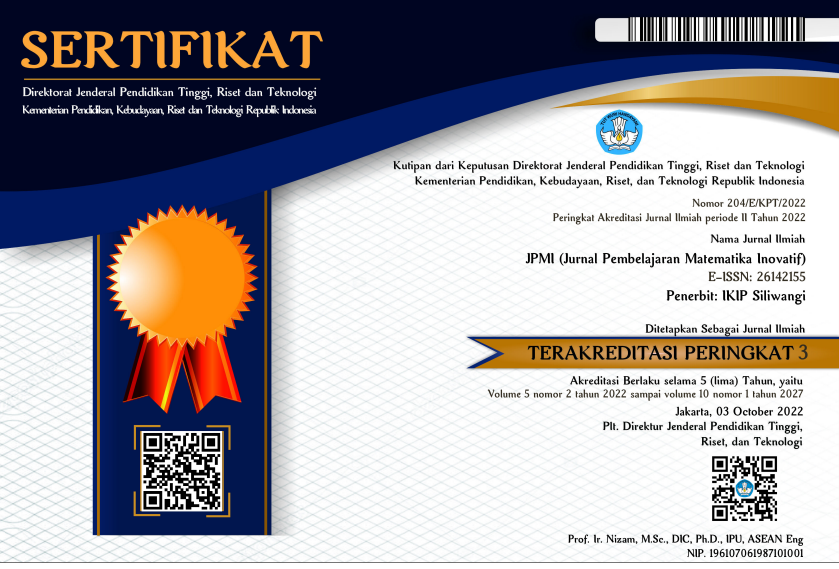ANALISIS LEVEL PROBABILISTIC THINKING ABILITY PESERTA DIDIK DALAM MENYELESAIKAN SOAL CERITA PELUANG DI SEKOLAH MENENGAH ATAS
DOI:
https://doi.org/10.22460/jpmi.v6i2.16989Keywords:
Probabilistic Thinking, ProbabilityAbstract
References
Ali, I. (2021). Pembelajaran Kooperatif Dalam Pengajaran Pendidikan Agama Islam. Jurnal Mubtadiin, 7(1), 247–264. http://journal.an-nur.ac.id/index.php/mubtadiin/article/view/82
Arum, D. P., Kusmayadi, T. A., & Pramudya, I. (2018). Students’ Difficulties in Probabilistic Problem-Solving. Journal of Physics: Conference Series, 983(1). https://doi.org/10.1088/1742-6596/983/1/012098
Azizah, H. S. N., Patmawati, H., & Nugraha, D. A. (2022). Analisis Kemampuan Berpikir Kreatif Matematis Ditinjau Dari Gaya Kognitif. Jurnal Kongruen, 4(1), 343–346.
Batanero, C., Arteaga, P., Serrano, L., & Ruiz, B. (2014). Prospective Primary School Teachers’ Perception of Randomness Carmen. Probabilistic thinking, 345–366. https://doi.org/10.1007/978-94-007-7155-0_19
Creswell, J. W. (2011). Education Research: Qualitative, Quantitative, and Mixed Methods Approaches (4 ed.). Pearson Education, Inc.
Ersoy, E. (2016). Problem Solving and Its Teaching in Mathematics. Journal of New Horizons in Education, 6(2), 79–87. www.tojned.net
Fa’ani, A. M., Masamah, U., & Marhayati, M. (2022). Level Berpikir Probabilistik Siswa SMPN 4 Kepanjen. Jurnal Axioma : Jurnal Matematika dan Pembelajaran, 7(1), 01–12. https://doi.org/10.56013/axi.v7i1.1187
Groth, R. E., Austin, J. W., Naumann, M., & Rickards, M. (2021). Toward a Theoretical Structure to Characterize Early Probabilistic Thinking. Mathematics Education Research Journal, 33(2), 241–261. https://doi.org/10.1007/s13394-019-00287-w
Hidayati, Y. M., & Afifah, N. (2020). Analisis Berpikir Probabilistik dalam Menyelesaikan Masalah Matematika. Premiere Educandum : Jurnal Pendidikan Dasar dan Pembelajaran, 10(2), 161. https://doi.org/10.25273/pe.v10i2.7069
Hidayati, Y. M., Afifah, N., Nurhidayat, Fuadi, D., Apuanor, Wiguna, A., & Waluyo, M. (2021). Probalistic Thinking Based on Probabilistic Thinking Responses to Math Problem Solving. Journal of Physics: Conference Series, 1720(1). https://doi.org/10.1088/1742-6596/1720/1/012017
Jones, G. A., Langrall, C. W., Thornton, C. A., & Mogill, A. T. (1999). Students’ Probabilistic Thinking in Instruction. Journal for Research in Mathematics Education, 30(5), 487–519. https://doi.org/10.2307/749771
Kazak, S., & Leavy, A. M. (2018). Emergent Reasoning About Uncertainty in Primary School Children with a Focus on Subjective Probability. 37–54. https://doi.org/10.1007/978-981-13-1044-7_3
Khalid, M., Saad, S., Abdul Hamid, S. R., Ridhuan Abdullah, M., Ibrahim, H., & Shahrill, M. (2020). Enhancing Creativity and Problem Solving Skills through Creative Problem Solving in Teaching Mathematics. Creativity Studies, 13(2), 270–291. https://doi.org/10.3846/cs.2020.11027
Khoirunnisa, S., Sujadi, I., & Subanti, S. (2021). Probabilistic Thinking Level of Junior High School Students with Low Mathematical Abilities Who Have Not Learn Probability Material. IOP Conference Series: Earth and Environmental Science, 1796(1), 433–441. https://doi.org/10.1088/1742-6596/1796/1/012050
Komalasari, M. D., & Wihaskoro, A. M. (2017). Mengatasi Kesulitan Memahami Soal Cerita Matematika Melalui Gerakan Literasi Sekolah Dasar. Prosiding SEMNAS PGSD, 1–12.
Maxine, P., & Constance, M. B. (1996). Building on and Challenging Students’ Intuitions About Probability: Can We Improve Undergraduate Learning? Journal of Statistics Education, 4(1). https://doi.org/10.1080/10691898.1996.11910502
Morrison, G. (2010). Designing Effective Instruction.
Nikiforidou, Z., Pange, J., & Chadjipadelis, T. (2013). Intuitive and Informal Knowledge in Preschoolers’ Development of Probabilistic Thinking. International Journal of Early Childhood, 45(3), 347–357. https://doi.org/10.1007/s13158-013-0081-6
Prasetyani, E., Hartono, Y., & Susanti, E. (2016). Trigonometri Berbasis Masalah Di Sma Negeri 18 Palembang. Jurnal Gantang Pendidikan Matematika FKIP - UMRAH, 1(1), 31–40. https://media.neliti.com/media/publications/261260-kemampuan-berpikir-tingkat-tinggi-siswa-06cbddac.pdf
Putridayani, I. B., & Chotimah, S. (2020). Analisis Kesulitan Siswa dalam Memahami Soal Cerita Matematika pada Materi Peluang. Jurnal Pembelajaran Matematika Inovatif, 3(6), 671–678. https://doi.org/10.22460/jpmi.v3i6.671-678
Raya, R., St Suwarsono, & Lukito, A. (2021). Probabilistic Thinking of Senior High School Students with Low Mathematical Abilities in Solving Probability Tasks. Journal of Physics: Conference Series, 1752(1). https://doi.org/10.1088/1742-6596/1752/1/012073
Rizal M, M., Tayeb, T., & Latuconsina, N. (2016). Efektivitas Penerapan Metode Ekspositori Berbasis Kuis Terhadap Hasil Belajar Matematika Siswa Kelas VIII MTsN Ma’rang Kabupaten Pangkep. MaPan, 4(2), 171–184. https://doi.org/10.24252/mapan.2016v4n2a2
Roswati, D., & Madawistama, T. (2022). Proses Berpikir Probabilistik Peserta Didik dalam Menyelesaikan Permasalahan Peluang. Jurnal Penelitian Pembelajaran Matematika, 15, 202–213.
Satriani, S., & Wahyuddin. (2018). Implementasi Model Pembelajaran Creative Problem Solving (CPS) Untuk Meningkatkan Kemampuan Pemecahan Masalah Mahasiswa. Jurnal Derivat, 5(1), 69–81.
Sharma, S. (2012). Cultural Influences in Probabilistic Thinking. Journal of Mathematics Research, 4(5), 657–681. https://doi.org/10.5539/jmr.v4n5p63
Shodiqin, A., Nuraini, A., & Wulandari, D. (2022). Profil Berpikir Probabilistik dalam Pemecahan Materi Peluang Kejadian Berdasarkan Self-efficacy. JNPM (Jurnal Nasional Pendidikan Matematika), 6(2), 229. https://doi.org/10.33603/jnpm.v6i2.5550
Shodiqin, A., Sukestiyarno, Y. L., Wardono, & Isnarto. (2021). European Journal of Educational Research. European Journal of Educational Research, 11(1), 69–81.
Siswondo, R., & Agustina, L. (2021). Penerapan Strategi Pembelajaran Ekspositori untuk Mencapai Tujuan Pembelajaran Matematika. Himpunan: Jurnal Ilmiah Mahasiswa Pendidikan Matematika, 1(1), 33–40. http://jim.unindra.ac.id/index.php/himpunan/article/view/3155
Sujadi, I., Kurniasih, R., & Subanti, S. (2017). The Effectiveness of Learning Material with Edmodo to Enhance The Level of Student’s Probabilistic Thinking. AIP Conference Proceedings, 1848(May). https://doi.org/10.1063/1.4983943
Taram, A. (2017). Probabilistic Thinking Ability of Students Viewed from Their Field Independent and Field Dependent Cognitive Style. Journal of Physics: Conference Series, 824(1), 012050. https://doi.org/10.1088/1742-6596/824/1/012050
Taram, Abdul. (2016). Proses Berpikir Probabilistik Mahasiswa S1 Pendidikan Biologi JPMIPA FKIP UAD Pada Pokok Bahasan Teori Probabilitas. AdMathEdu : Jurnal Ilmiah Pendidikan Matematika, Ilmu Matematika dan Matematika Terapan, 6(1). https://doi.org/10.12928/admathedu.v6i1.4757
Taram, Abdul, Sukestiyarno, Y. L., Rochmad, & Junaedi, I. (2020). Cooperative Learning Based on Probabilistic Thinking Profile SMP Muhammadiyah 3 Mlati Regency of Sleman. Journal of Physics: Conference Series, 1613(1). https://doi.org/10.1088/1742-6596/1613/1/012078
Till, C. (2014). Fostering Risk Literacy in Elementary School. International Electronic Journal of Mathematics Education, 9, 83–96. https://www.iejme.com/article/fostering-risk-literacy-in-elementary-school
Uyun1, B., & Moh. Sutomo2. (2021). Pelaksanaan Metode Pembelajaran Tutor Sebaya Pada Pembelajaran Ilmu Pengetahuan Sosial Tahun 2019/2020. Journal of social Studies, 1(tutor sebaya), 97–113. file:///D:/Bahan jurnal/bahan tutor teman sebaya/tutor sebaya badriyatul uyun.pdf
van Hooijdonk, M., Mainhard, T., Kroesbergen, E. H., & van Tartwijk, J. (2020). Creative Problem Solving in Primary Education: Exploring the Role of Fact Finding, Problem Finding, and Solution Finding across Tasks. Thinking Skills and Creativity, 37(April), 100665. https://doi.org/10.1016/j.tsc.2020.100665
Yekovich, F. R., Thompson, M. A., & Walker, C. H. (1991). Generation and Verification of Inferences by Experts and Trained Nonexperts. American Educational Research Journal, 28(1), 189–209. https://doi.org/10.3102/00028312028001189
Yelisa, M. (2015). Meningkatkan Kemampuan Penjumlahan Bilangan Pecahan Sederhana Melalui Media Batang Cuisenaire Bagi Anak Berkesulitan Belajar X. Jurnal Ilmiah Pendidikan Khusus, 4(September), 224–233. https://media.neliti.com/media/publications/261260-kemampuan-berpikir-tingkat-tinggi-siswa-06cbddac.pdf

















